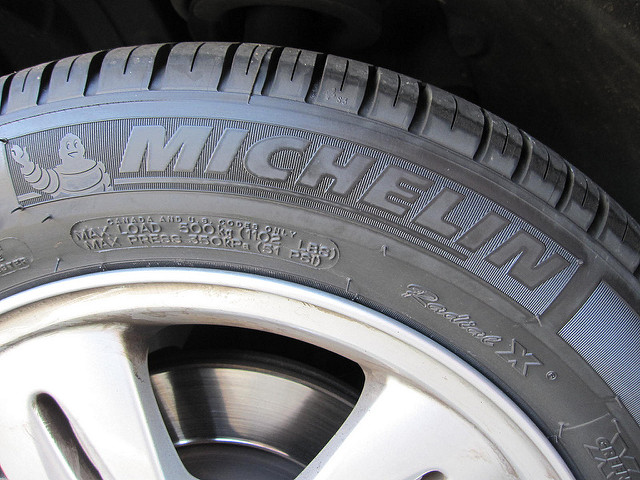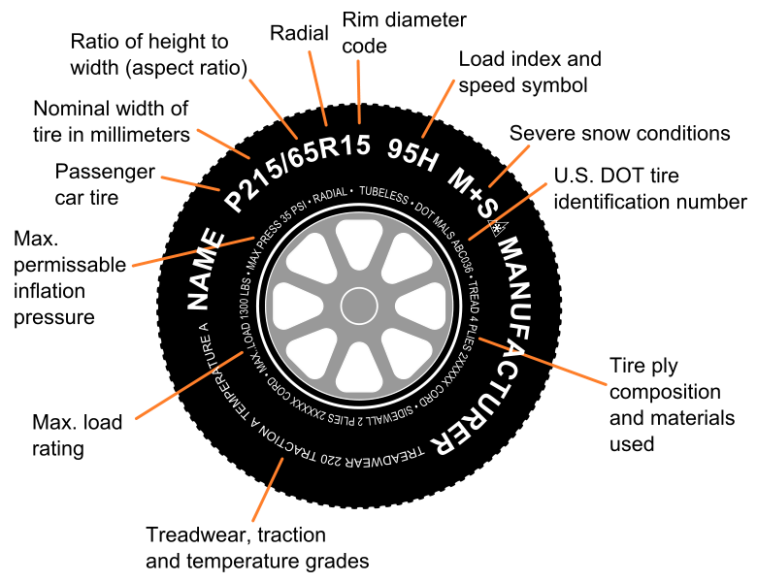Tire Translator: What Do All Those Numbers and Letters Mean?

Photo: toyohara
At first glance, all those numbers and letters on tire sidewalls seem impossible to comprehend. However, each section conveys important information about the tire’s type, size, and more. Here’s a look at what all that tire text means.
Brand and model
The biggest type on a tire’s sidewall will indicate its brand and model. This information is especially useful when you’re buying a used car — you’ll want to make sure that all four tires match.
Tire type
Figuring out your tires’ brand and model was easy, but the next text you’re likely to encounter is something that looks a jumble of letters and numbers — for example, “P215/65 R15.” Uh, what?
Well, let’s start breaking it down. The letter “P” tells you that the tire is designed for a passenger vehicle. There’s also LT for light trucks and T for temporary (think spare) tires.
Tire width
Continuing with our “P215/65 R15” example, the next thing you’ll see is the number 215. This tells you the width of your tire in millimeters when it’s measured from sidewall to sidewall.
Sidewall height
After the forward slash, the next number on our example tire is 65. This is the tire’s aspect ratio, or its percentage of width to sidewall height. In this case, 65 means that the tire’s height is 65% of its width. Multiply 215 by 0.65, and you get 139.75 millimeters.
As a side note, tires with a lower aspect ratio are generally built for higher performance, while tires with a higher aspect ratio generally provide a more comfortable ride.
Tire construction
The next part of our “P215/65 R15” example is the letter R. This means that the tires are built with radial construction. Older tires sometime have the letter D for “diagonal bias” or B for “bias belted.”
Wheel size
The final part of “P215/65 R15” is the number 15. This indicates that the tire is designed to fit a 15-inch rim.
Maintaining Your Tires: How to keep them in good condition — and when to replace them

Image: F l a n k e r
Maximum load and speed ratings
The next text you’ll see is a number-letter combination. The number is the load rating, or the amount of weight that it can handle. The letter is the speed rating, or the maximum speed the tire is built for. As an example, a tire rated 90R could safely carry 1,323 pounds and travel at 106 mph. Consult a load and speed index to find out what your tire’s specific rating means.
Tire date
Your tire will also have a combination of letters and numbers called the DOT Code. The most important part of this combination is four digits that indicate when your tire was manufactured. For example, “2118” would mean that the tire was made during the 21st week of 2018.
Maximum inflation rating
This rating is generally expressed as both pounds per square inch (psi) and kilopascals (kPA). Don’t inflate your tires to this maximum, though. For the recommended pressure, check the owner’s manual or the tire information label on the driver’s side doorjamb.
Uniform Tire Quality Grading (UTQG)
This quality grading system comes from the National Highway Traffic Safety Administration and provides information about a tire’s tread wear, traction, and temperature ratings.
Tread wear testing varies from manufacturer to manufacturer, so this number isn’t always helpful — check your tire’s warranty for more information. Traction is rated at C, B, A, and AA, with AA considered the best. Temperature ratings measure how well the tire can withstand heat. They’re listed as either C, B, or A, with A being the best.
Other information
See the graphic above for other information you might find on a tire.
Safe and Connected: Discover the benefits of driving with OnStar
Sources: U.S. News & World Report, How Stuff Works
A longtime editor/writer and recently transplanted Hoosier, Caleb Cook lives in Xenia, Ohio. His favorite activities are reading and listening to music, although he occasionally emerges from the heap of books and vinyl records in his basement to stand blinking in the sunlight. Once fully acclimated to the outside world again, he can be observed hanging out with his wife, attempting a new recipe in the kitchen, attending movies, walking the dog, or wandering into a local brewery to inquire about what’s on tap. See more articles by Caleb.

